Aerojet Rocketdyne wins contract from Lockheed Martin to build more Orion engines
Aerojet Rocketdyne announced yesterday that it has been awarded a new $67 million contract from Lockheed Martin to build the Orion propulsion engines for Artemis missions six though eight.
This contract option includes delivery of three additional sets of Orion’s service module auxiliary engines and three additional jettison motors. The eight auxiliary engines each produce 105 pounds of thrust to help maintain Orion’s in-space trajectory and position, and supplement the Orion Main Engine. The jettison motor, located on Orion’s Launch Abort System (LAS), generates 40,000 pounds of thrust to separate the LAS from the crew module during both nominal operations and abort scenarios, allowing the spacecraft to continue on its journey. The jettison motor is the only motor on the LAS that fires during every mission.
These Artemis missions are not expected to occur until very late in this decade, by which time Starship will likely be making regular commercial trips to the Moon. At that time Orion will look increasingly ridiculous next to Starship, and will demonstrate starkly the difference in what government can do versus a free private sector.
Aerojet Rocketdyne announced yesterday that it has been awarded a new $67 million contract from Lockheed Martin to build the Orion propulsion engines for Artemis missions six though eight.
This contract option includes delivery of three additional sets of Orion’s service module auxiliary engines and three additional jettison motors. The eight auxiliary engines each produce 105 pounds of thrust to help maintain Orion’s in-space trajectory and position, and supplement the Orion Main Engine. The jettison motor, located on Orion’s Launch Abort System (LAS), generates 40,000 pounds of thrust to separate the LAS from the crew module during both nominal operations and abort scenarios, allowing the spacecraft to continue on its journey. The jettison motor is the only motor on the LAS that fires during every mission.
These Artemis missions are not expected to occur until very late in this decade, by which time Starship will likely be making regular commercial trips to the Moon. At that time Orion will look increasingly ridiculous next to Starship, and will demonstrate starkly the difference in what government can do versus a free private sector.













